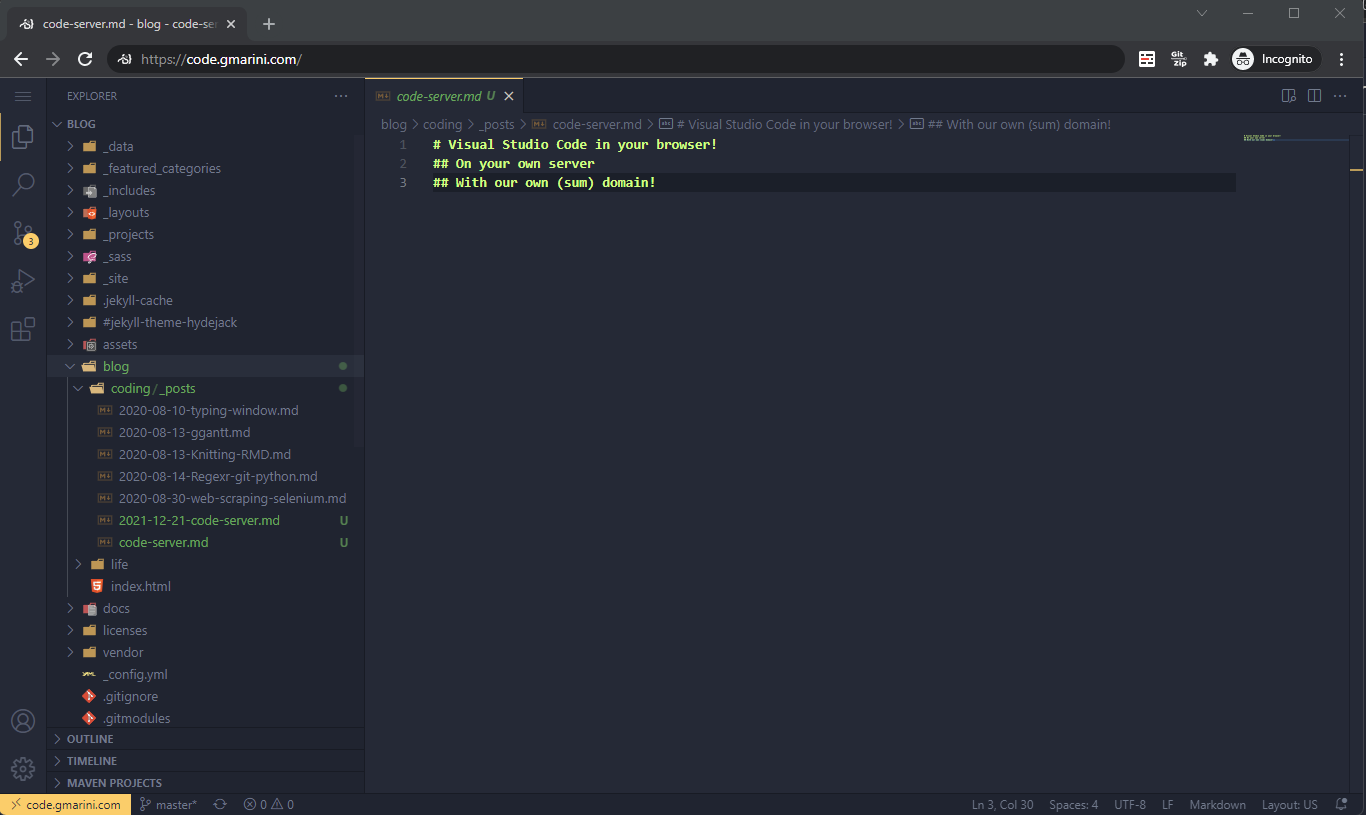Diamond Beach Ice Beach Iceland
Jan 2018
48


I like my website to be lightweight and static, which is one of the reasons I stuck with Jekyll! One of the pros is being able to write articles in Markdown which I find quicker, easier and less distracting than Google Docs, Word or even LaTeX.
I also like to have full control over my website and my server, which is why I set up Jekyll in a dedicated server through a cheap hosting service and my own domain from Google Domains.
When self-hosting your website however, adding new posts or even making small changes to your website can be rather time consuming. This is especially true when working from different machines.
I eventually came across Coder and the free cloud-editing service behind it code-server.

A little update on what’s been going on!
So I disappeared for a while but here I am again! Many things have changed in the past year which is also why I was not very active in writing more content! Here are some updates regarding my PhD journey, my career and the life in Australia during the COVID pandemic…
Sometimes the data you want or need is not readily avaialble as a nicely formatted .csv file. Sometimes it’s an HTML table or even worse a convoluted mess of li ul or ol tags. We might be lucky and be able to copy-paste the table content to an Excel spreadsheet, but what if the table is split in multiple pages? And what if those pages are dynamically filled with Javascript? We would need some browsing capabilities and not just a static page crawler.
For this example, I’ll scrape data from a Plant DNA C-Values Database website. The website has a search function which dynamically loads data in a table displaying the search result.
python and regular expressions regEx A big portion of my PhD is to deal with patterns. They present themselves in many ways: Movements, images and pixels, sounds etc… But since computers deal mostly with numbers and code, the easiest way is to reduce any pattern to text, or code.
Text, especially code, can easily be parsed by defining patterns and looking for them. Think about it as if you are reading a page of a book or even a website: You look for patterns, be it an email, a phone number, the structure of a sentence.
While the semantic of a sentence is not easy to parse and understand for a computer (see the whole branch of NLP), encoded and marked text can easily be captured by specifying patterns. Emails for instance are defined by username@domain and we all know how to read them, we all know that username is anything that preceeds the @ character, and anything after it is the domain.
I find this concept of patterns, text and encoding extremely fascinating and stimulating. I might make a post just about them but for now let’s focus on this little project.
Alright so I am finally doing it! I am describing how I make Gantt charts in R, and how I want to make it easier to generate them through shiny dashboards. This is an R Markdown document. Markdown is a simple formatting syntax for authoring HTML, PDF, and MS Word documents. For more details on using R Markdown see http://rmarkdown.rstudio.com.
When you click the Knit button a document will be generated that includes both content as well as the output of any embedded R code chunks within the document. You can embed an R code chunk like this:
One thing I would love to do with this blog is to post data anlysis done in R (or Python sometimes). They can be a lot of fun and I would prefer to spend the time writing the R notebook rather than converting it afterward to pure Markdown for Jekyll. So here is a few tips for an easy R Markdown to Jekyll Markdown port (Thanks to this guide ). Another interesting package is blogdown whith has Jekyll support. The most interesting part was their code for generating markdown files and figures in different folders
I made a gif of me mashing the keyboard on hackertyper and it got me the idea of using this terminal as a welcoming animation!
So I wanted to give my blog a cool vibe while also looking good. I did not want it to be too overwhelming with effects, sliding animations and such. So I opted for something simple, it’s just text after all! But it’s also quite catchy and fun to watch.
So here is how I have achieved this effect, it’s nothing crazy hard really but I love playing with CSS and Javascript and so I did.